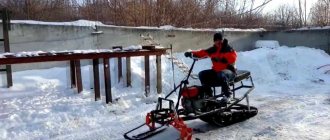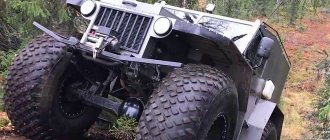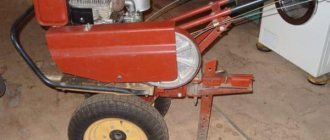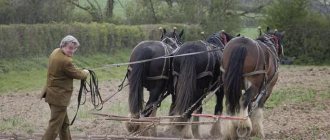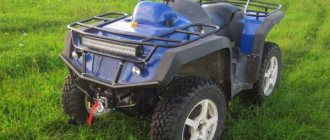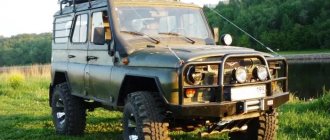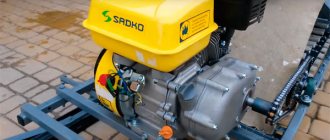Instructions for making a homemade blade for a tractor in Belarus. From manufacturing to assembly.
A tractor blade, also called a shovel, is one of the variations of attachments for MTZ brand tractors, the use of which allows you to turn an ordinary tractor into a kind of bulldozer and use it to clear the territory of snow, move soil and other bulk materials within the working or construction site. Today we’ll talk about how to make a similar design at home.
Low pressure.
Questions can only be asked after registration.
Please login or register. What could be the reason for low pressure on a hot engine? D-240 engine, when I start it, it shows 300-350 kPa, it heats up to 80, the pressure drops to 100 kPa. on the old unit, when hot, it did not drop below 250, I changed the unit and the same problem began
There are many reasons, oil pump, liner-crankshaft gaps, tightening the drain valve on the centrifuge will not help, change the oil pump
choosing from these reasons, I already tightened the valve, changed the liners and the crankshaft 2 years ago (I didn’t have to separate the crankshaft. I’ll have to change the oil pump. But could it depend on the oily radiator?
choosing from these reasons, I already tightened the valve, changed the liners and the crankshaft 2 years ago (I didn’t have to separate the crankshaft. I’ll have to change the oil pump. But could it depend on the oily radiator?
Yes, the gaps are fine, I changed the liners. I just had an old block and the fist showed on it, I changed the block and the pressure became low
What could be the reason for low pressure on a hot engine? D-240 engine, when I start it, it shows 300-350 kPa, it heats up to 80, the pressure drops to 100 kPa. on the old unit, when hot, it did not drop below 250, I changed the unit and the same problem began
I worked on the tractor for almost 30 years, but recently I encountered a drop in pressure, I ground the crankshaft a year ago at home, a mechanic I know measured the shaft journals and said it was bored out perfectly for cold 4 and for hot 1 pressure, I ground the valves in a tsintrafuge, tightened the pressure reducing valve to the end, replaced it with a new oil pump the result did not change, changed the oil with high viscosity to cold, began to press 5 to hot 1.5. I already wanted to remove the engine but decided to check the centrifuge again, unscrewed the tube that goes to the sensor in the cabin, connected the compressor to the fitting and, under pressure, checked the tightness of the centrifuge, here it was REASON FOR LOW PRESSURE Oil was flowing from under the rotor cap in all directions, it turns out that the sealing rubber ring was worn out, I changed it to a new one and the result on a cold engine at low speeds showed 5.5, warmed up to eighty 5, adjusted the valve, now it doesn’t drop below 3. And I almost disassembled the engine, check the centrifuge and the tube on the rotor that goes into the body of the centrifuge must fit tightly. This is the exact story that happened, live and learn.
Only those who do nothing make no mistakes
Source
Photo
Thanks to the structural continuity of the T-130, T-170, T-10, T-11 models, spare parts for the older model can be found even in our time. This fact will undoubtedly please consumers, since this will allow for repairs and continued operation of the T-130 model, which has been out of production for quite some time. Moreover, advanced components can be installed on old equipment, making it more comfortable and productive. Models T-130, T-170, T-10, T-11 have almost the same dimensions and weight.
Centrifuge MTZ-80: device
On diesel D - 240
a new active-reactive centrifuge was used. Unlike a reactive one, it does not have nozzles.
All oil entering the rotor is supplied to the main oil line.
8
is fixedly attached to axis 9 , having channels
A
tangent to its circumference.
Centrifuge operation diagram
At the top of the body 7
The rotor has tangentially located channels.
B.
_
Unrefined oil under pressure enters through the annular cavity B
(between the axle and the tube) into
channels
A. Flowing out of these channels under pressure, the oil jets form an active torque, which causes the rotor to rotate in the direction of the jet movement, as shown in Figure 4
.
The purified oil is ejected at high speed through channels B
in the upper part of the rotor and enters the stationary axis channel and then into the oil line. In this case, a reactive force arises, which also rotates the rotor. Thus, the centrifuge rotor rotates due to the total energy of two oil flows: active and reactive.
Diesel centrifuge D-240
The rotor consists of a housing 16
(Fig. 6) and glasses
17
.
The area of the upper bottom is larger than the area of the bottom. The total oil pressure force directed upward is greater than the force acting on the bottom of the rotor. As a result, when the engine is running, the rotor floats up and unloads the supporting end. The rotor is kept from moving upward by a thrust washer 18
, and downwards by the shoulder of the axle
13
.
Axial run - 0.3...1.5 mm. There are three valves installed in the filter housing: bypass 12
, drain
8
, and radiator
4
.
Bypass valve
(
12
) maintains oil pressure in the rotor.
If at the entrance to the rotor it rises to 0.65 MPa (with thick oil or a dirty rotor), the valve opens and the unrefined oil is drained into the engine crankcase. For some engines, the oil is transferred to the main oil line, bypassing the centrifuge. The bypass valve is adjusted with screw 10
to a pressure of 0.65…0.70 MPa.
Radiator valve
(
4
) is necessary to bypass cold oil, bypassing the oil cooler into the engine oil channels. Radiator valve is not adjustable
Drain valve 8 is designed to drain excess purified oil into the crankcase when the pressure in the channels increases. The valve is adjusted with screw 10 to normal oil pressure in the system.
The design of these valves is identical to that of the oil pump valves.
Auger snow blower
A snow blower becomes especially in demand when, after snow has fallen, the owner of the house is faced with the problem of cleaning an area of a certain size with his own hands. Serial, factory-made snow blowers are not very cheap, and therefore many country house owners try to assemble them with their own hands.
Most often, the working part of a snow blower is an auger. This is probably the most difficult part. To manufacture it, you must have at least competently executed drawings. Mistakes are guaranteed to lead to the fact that the auger will hit during rotation, and as a result the machine will be thrown from side to side. Such an impact will sooner or later lead to the fact that the snow blower made by yourself will fail.
Screw devices are divided into two types - one- and two-stage. In the first devices, a screw is used as a working body, and in the second, both a screw and a rotor are used.
Lubrication system of the MTZ-82 (MTZ-80) tractor
The engine of the MTZ-82 (MTZ-80) tractor uses a combined lubrication system: one part of the parts is lubricated under pressure, the other - by splashing oil.
The engine cylinder block has a longitudinal oil channel, from which oil is supplied through transverse channels to each main bearing and to all camshaft journals.
The crankshaft and camshaft bearings, the idler bushing and the fuel pump drive gear, as well as the valve train, are lubricated under pressure from the gear oil pump.
Liners, pistons, piston pins, camshaft cams, and pump drive are splash lubricated.
Rice. 20. Centrifugal oil filter:
1 — rotor axis; 2 — centrifugal filter housing; 3 - nozzles; 4 — locking screw; 5 - tube; 5 — rotor housing; 7 — inner glass; 8 — rotor housing cover; 9 — stacked rotor; 10 — special nut; 11 — sealing ring; 12 — thrust washer; 13 — nut; 14 — centrifugal filter cap; 15 - ring; 16 — cap nut; 17 — washer; 18 — safety valve; 19 — drain valve: 20 — radiator valve (reducing); 21 - screw; 22 — tangential holes; 23 - radial holes.
General lubrication instructions
Depending on the ambient temperature, use oils of different viscosities according to this manual. The physical and chemical properties of the oils used must correspond to those indicated in the table “Oils and lubricants used for Belarus tractors.”
Main systems of the D-240 engine
The D-240 engine of the MTZ-80, 82 tractor has a closed liquid cooling system (it communicates with the environment only briefly, through a valve).
Cooling system with starting gasoline engines, common (combined). It works as follows.
Rice. 1. Cooling system D-240
The water pump (pump) of the D-240 engine (8 in Fig. 1) takes cooled liquid from the lower 3 radiator tank and pumps it into the diesel cooling jacket (and the starting engine, if equipped), displacing the heated liquid from it into the upper radiator tank.
Flowing through the tubes, the radiator core 12 from the upper 14 tank to the lower 3 tank is cooled by air, which is sucked in by fan 10.
The temperature of the liquid in the system is controlled using thermometer 17. The optimal operating temperature is 80...97°C.
For manual regulation of the thermal state of the diesel engine, a curtain 5 is provided.
In a cold engine of the MTZ-80, 82 tractor, the thermostat 20 bypasses the cooled liquid to the water pump, thereby eliminating unnecessary cooling in the radiator.
The radiator filler neck is hermetically sealed with a cap 16 with steam and air valves. The pump is structurally combined with the fan.
Water pump (pump) D-240
The release of copious amounts of steam, leakage of water or oil from the drain hole, increased noise and knocking indicate a malfunction of the cooling system, in particular a malfunction of the pump.
The performance of the cooling system depends on the amount of liquid, the degree of wear of the impeller blades and pump walls, the tension of the fan drive belts, the condition of the radiator core and other reasons.
The amount of liquid in the cooling system of the MTZ-80, 82 tractor may decrease as a result of leaky connections, violation of the steam-air valve adjustments, or destruction of the water pump seals.
Loss of coolant leads to overheating of cylinder head parts, failure of injector cup seals, cylinder liners, burnout of cylinder head gaskets, etc.
The appearance of significant clearance in the bearings or its destruction can lead to damage to the radiator core by the fan impeller.
If there are cracks on the housing of the D-240 water pump, detected by external inspection, it is replaced with a new or repaired one.
Increased noise and knocking indicate extreme wear or destruction of the water pump bearings, weakening of the seat for the drive pulley.
The appearance of a coolant leak from the drainage hole or traces of oil on the drive pulley indicates the destruction of the cuffs and seals of the water pump roller.
When these malfunctions occur, the water pump is removed from the engine to replace worn parts.
If the axial movement of the roller in the bearings exceeds 0.6 mm or the inner rings of the bearings on the roller are weakened, then it must be replaced complete with bearings.
What kind of oil to fill in Neva walk-behind tractors
The quality of the lubricating fluid in the walk-behind tractor gradually decreases and becomes unusable. Along with this process, engine wear occurs. To prevent wear and tear, lubricant mixtures must be changed promptly. The instructions indicate the recommended brand and quantity. When purchasing, you must take into account the level of its viscosity and quality classification. For the Neva walk-behind tractor, you need to purchase oil for the gearbox and engine.
The Neva walk-behind tractor is equipped with different motors. They require lubricants of different brands and manufacturers. They should be poured into the engine taking into account the viscosity and category.
If a device with a Honda engine is purchased for a plot of land, it can be filled with SAE 10W-30 in summer and winter. The same universal remedy is suitable for the Lifan engine. Subaru produces lubricant for its equipment itself. With a Subaru engine you need to buy lubricant from the same company. Her brand is Ow20. It is suitable for winter and summer engine operating conditions. It is permissible to fill in 5w-30 from the same manufacturer instead.
The Briggs & Stratton engine is filled with SAE 10W-30 summer engine oil. For winter conditions, SAE 5W-30 is suitable. Its consumption is higher than that of other motors, so the level needs to be checked more often. If necessary, lubricant is added to the specified level.
The gearbox is an important part of the walk-behind tractor. For proper operation, it is necessary to fill the gearbox of the Neva walk-behind tractor with good quality oil and replace it periodically. These oils include TEP-15 and TM-5. Its volume is 2.2 liters. The hot used liquid is drained through a special hole and fresh is poured in. These types are suitable for MB-1 devices. When replacing, the unit is installed in a vertical position, and a container is placed under it to drain the waste.
If the walk-behind tractor is rarely used for work, replacement is done at least once every two years. The Neva MB-2 unit needs to be filled with TAP-15V oil; instead, you can use the TAD-17I brand.
You need to know when to change the oil. In a newly purchased unit, you need to check its level. Some walk-behind tractors are sold without lubricants. If necessary, you can add oil and run the device for 20-25 hours. Then replacement is made after 100-250 hours. The deadlines are indicated in the instructions.
Centrifuge of the MTZ 82(80) tractor: device, disassembly, maintenance and adjustment
The cleanliness of the oil in an internal combustion engine is important. The absence of foreign inclusions in the oil ensures optimal lubrication and preservation of the service life of the rubbing surfaces in the joints of the piston group parts and the crank mechanism. The lubrication system of the D-240 diesel engine and its modifications of MTZ tractors includes a centrifuge. The function of the unit is to clean the circulating oil in the engine system from contaminants, and the name itself speaks of the centrifugal principle of operation.
How to make a snow blower from a walk-behind tractor
You can assemble a snow blower with your own hands when you have collected the following material and tools:
- welding machine;
- angle grinder;
- electric drill;
- a set of metalwork tools;
- sheet metal for making an intake casing;
- metal for making a screw.
- metal corner 50×50;
- ball bearings;
- plywood;
- pipes for making the control handle and auger shaft.
The collected material is enough to make a frame and auger for a snowblower with your own hands. Cut metal rings from pre-prepared iron. After cutting the ring, bend the remaining halves into a spiral segment.
Then the segments must be welded into a single piece. The resulting spiral is welded to vertical posts pre-installed radially on the screw shaft. In order to make the auger, you might consider hiring a professional welder. During the manufacturing process of this unit, you must always remember that even a small error can lead to unstable operation of this unit.
Bearings are placed on the ends of the pipe. This way the auger will be ready.
Centrifuge device
MTZ tractors with D-240, D243, D245 engines are equipped with full-flow centrifuges with a nozzleless hydraulic drive under catalog numbers 240-1404010-A , 240-1404010-A-01 , 240-1404000-A , which do not differ in design and are interchangeable .
An example of equipping with nozzle centrifuges are diesel engines SMD-62, D-65, tractors T-150, YuMZ-6, where the unit in the bottom of the rotor has jet nozzles for hydraulic drive.
In the tractor configuration, the unit is located on the right side and is connected by its bracket body to the diesel unit. At the same time, at the place where the unit is attached to the block, a connection is provided between the oil lines in the block and the centrifuge. The centrifugal drive of the device is carried out by the pressure created by the engine oil pump.
Rotor
The unit consists of a housing and an axis of rotation with a rotor installed in it. The latter includes a frame, an inner glass, an upper and a lower lid. The top cover is secured to the frame with a nut and sealed with a rubber ring. The axial movement of the rotor on the axis is limited by a nut installed through a washer at its threaded end. The axle has an oil-conducting channel inside. The rotor is closed on top with a protective cap and tightened with a nut and washer. And also to improve the quality of cleaning, later full-flow centrifuges for diesel engines of MTZ tractors additionally installed a filter mesh on the rotor housing.
Frame
The housing is made in one piece with the mounting bracket of the unit, equipped with channels and valves:
Supply channel , fed through a pipeline from the oil pump and connected to the channels of the centrifugal hydraulic drive of the rotor.
The pressure channel passes purified oil into the diesel main line.
Drain channel - connected to the cavity of the diesel crankcase.
An unregulated safety valve is installed at the inlet of the rotor - it cuts off oil into the diesel sump when the pressure increases above 0.65-0.7 mPa (6.5-7 kgf/cm²), that is, when the resistance to the passage of lubricant through the centrifuge increases as a result of the accumulation of contaminants, the valve will operate and will open the drain into the diesel sump.
The adjustable drain valve maintains the pressure in the system within 0.2-0.3 MPa (2-3 kgf/cm²). When starting a diesel engine, cold thick oil can create a pressure of the above operating values, which can cause an emergency situation in the operation of the diesel engine (for example, in the form of squeezing out oil seals). The purpose of the drain valve is to equalize the pressure value to 2-3 atmospheres by passing part of the oil into the drain.
The non-adjustable pressure reducing valve is designed to redirect cold oil past the oil cooler when starting the diesel engine. The force of the valve spring is less than the resistance of the radiator when unheated grease passes through it. After the diesel temperature rises to the operating value of 80-95°C and the oil loses its viscosity, the resistance to passage through the radiator will drop and the pressure reducing valve will close the drain channel, directing the oil through the lubrication system radiator for cooling.
Types and their technical characteristics
Manufacturers of walk-behind tractors and mini-tractors prescribe the use of motor oils for both gasoline and diesel products. The motors are being tested at the factory. At this time, lubricants are used that are recommended in the instructions.
For walk-behind tractors running on gasoline, it is recommended to pour the following types of liquids into oil containers:
- SA - for work with low loads;
- SB - for work with medium mechanical load;
- SC - used in engines without PCV valves;
- SD - works in engines with PCV;
- SE - lubricant for use in engines manufactured since 1980;
- SF is a higher quality analogue of the previous oil;
- SH - used in many engine systems.
Category SB has good anti-corrosion properties. The product efficiently lubricates cylinder walls and bearings. SF reduces the amount of oil deposits in 4-stroke and two-stroke engines.
With the recommended motor oil, owners increase the resource of the unit and reduce diesel fuel consumption for a diesel walk-behind tractor. The instructions for a walk-behind tractor with a diesel engine indicate the following categories of lubricants:
- SA - for working with low loads;
- SV - for working with high-sulfur fuel;
- CC - for a non-turbocharged engine operating under increased loads.
Category CA reduces the amount of carbon deposits in the cylinders, but reduces the quality of the lubricant. Any lubricant is poured in the required volume. Reducing or increasing it leads to jamming of the motor.
The Tarpan motor cultivator is a universal small-sized unit designed for mechanization of heavy physical labor for cultivating soil on personal plots.
The recommended cultivated area is up to 0.2 hectares.
Tarpan motor cultivators are produced in the city of Tula at the Tulamashzavod plant.
A distinctive feature of the cultivator is the ability to disassemble it into two parts and fit in the trunk of most sedans.
The MK can be transported by disconnecting the power unit 1 (see figure below) from the executive unit 2. To do this, it is necessary to release the hinged bolts 3. When transporting the MK, it is necessary to lay it in such a way as to prevent oil from spilling out of the gearbox (through the hole in the filler plug), from the engine crankcase and residues, fuel from the fuel tank.
| Main settings | Meaning | |
| Overall dimensions, mm, no more (control handles folded) | length 1300 (760) width 700 height 1060 (760) | |
| Weight, kg | 45 | |
| Tillage width, mm | 560 | |
| Cultivator cutter diameter, mm | 320 | |
| Productivity, ha/h (with normal soil and loosening depth of 180 mm) | 0,06 | |
| Loosening depth max., mm | 200 | |
| Limit angles of inclination during operation, degrees, longitudinal and transverse, no more | 15 | |
| Engine | briggs stratton | honda |
| Model | 12j802 | GCV-160 |
| Type | 4-stroke, carburetor | |
| Working volume, cubic meters cm. | 190 | 160 |
| Max. power, hp, not less | 5,5 | 5.5 |
| Fuel tank capacity, l | 1,1 | |
| Oil fill volume, l | 0,6 | 0,55 |
| Fuel and oil in accordance with the Engine Operating Manual | ||
| Hourly fuel consumption, l/h, no more | 1,1 | |
| Clutch | Dry automatic centrifugal | |
| Start | Manual action | |
| Shutdown | Remote throttle lever | |
| Gearbox | Single stage worm | |
| Worm gear lubrication oil - TAD-17I GOST 23652-79. Allowed replacement - transmission oils of class SAE 90, SAE 75W/90, API categories GL-4, GL-5 | ||
| Oil volume in the gearbox, l | 0,35 | |
| Sound level at the operator's workplace, no more than dBA | 81 | |
| Correction level of vibration velocity on the control handle, no more than dB | 118 | |
| Number of speeds | 1 forward | |
The Tarpan MK is equipped with an engine model 12j802 or model GCV-160
— working volume: Briggs & Stratton — 190 cm3; Honda - 160 cm3;
— maximum power of at least 5.5 hp.
You can find out what kind of fuel and oil to fill into the Tarpan cultivator from the user manual for the engine or from the table in the instructions.
The Tula Machine-Building Plant produced Tarpan cultivators in 1991. The first models were equipped with low-power domestic engines, so they did not arouse much interest among farmers. In 1997, cars with American four-stroke engines appeared on the market. The demand for equipment began to increase, and the owners were able to appreciate it.
Tarpan cultivators are operated on an area of up to 15 acres. Sophisticated design and good technical performance made them competitive.
Tarpan machines have been on the market for about 25 years. Positive reviews from owners confirm that the units have numerous positive characteristics:
- Disassembles into two parts. This greatly facilitates transportation;
- A high-quality engine and durable elements combine well, providing the ability to process even heavy soils;
- High speed of plowing of land - about 2 acres per hour;
- The motor in a vertical position can be easily removed;
- Ability to use different attachments;
- Minimum number of settings. The unit is easy to operate. No need for regular maintenance;
- Light weight and compact. The motor cultivator easily turns in any direction. The assembled unit takes up minimal space. When disassembled, it can even fit into the trunk of a car.
There are certain disadvantages in the design:
- The cutters are located at right angles, so they quickly become clogged;
- No reverse speed;
- Before changing the engine oil, the clutch is removed and the fastenings are unscrewed.
All systems and components of motor cultivators are well thought out, therefore reliable and durable. The manufacturer sought to create universal equipment for solving various agricultural problems.
Features of the Tarpan technique:
- Almost all units with a Briggs&Stratton engine with a power of 5-6 hp;
- One or two speed transmission;
- Air cooling protects the power plant from overheating and reduces the number of breakdowns;
- Improved grip with reliable spark plugs;
- Worm gear. It is more reliable than belt or chain transmission. The mechanism works with it for a long time without replacing this element;
- Plowing is performed at a depth of 16 - 25 centimeters;
- Surface working width 25 - 100 centimeters;
- Two pneumatic wheels for easy transportation;
- The handles are height adjustable to suit the operator's height;
- The handles with rubber pads are comfortable, the angle of the steering rod is adjustable;
- Replacement of spare parts in case of malfunction. They can be purchased at a specialty store at an affordable price.
Engines for Tarpan motor cultivators are four-stroke single-cylinder:
- Champion. American engine with a power of 5.5 liters. With. Provides an efficiency of 0.06 hectares/hour;
- Briggs & Stratton. Power in the range of 5.5-6 liters. pp., productivity reaches 0.06 ha/hour;
- Honda. The engine is considered the most reliable. Power up to 5.5 l. With.
Excellent parameters make the equipment durable and repairable.
Model TMZ-MK 03 is in great demand. Thanks to the modular design, equipment can be stored in a summer cottage and transported in the trunk of a car. Not only canopies are removed, but also the power plant.
Features overview:
- Four-stroke gasoline engine with a power of 6 hp. With.;
- Engine capacity – 190 cm3;
- Gearbox – 1 speed forward;
- Number of cutters – four pieces;
- Working width – 35, 70, 100 centimeters;
- Cultivation depth – 20 centimeters;
- The weight of the unit is 45 kilograms.
Tarpan TMZ-MK 03 is complemented by various attachments:
- Plow;
- Rake
- Hiller;
- Lawn mower;
- Rotary cutter.
Working with attachments is easier due to their compact size and handles that adjust to the operator.
The proposed video will allow you to familiarize yourself with the design characteristics and specific operation of the unit.
The Tarpan petrol cultivator loosens normal and heavy clay soils, introduces fertilizers, and removes weeds. The vehicle has high traction force and good maneuverability thanks to the installed power plant from an American manufacturer.
The worm gearbox and automatic centrifugal clutch allow the unit to be operated regardless of conditions.
Technical specifications:
- Four-stroke gasoline engine with a power of 6 hp. With.;
- Engine capacity – 190 cm3;
- Gearbox – 1 speed forward;
- The number of cutters (crow's feet) is four;
- Plowing width – 56 centimeters;
- Cultivation depth – 20 centimeters;
- Weight – 43 kilograms.
Tarpan electric cultivators are also worth attention. They operate on an electric power plant with a power supply of 220W. Email The Tarpan cultivator has slightly less power than the gasoline model. But the soil treatment parameters and design features are no different.
When using equipment, it is important to study the operating instructions. Based on it, maintenance and care of the unit is performed.
Tarpan LLC is a subsidiary of the Tulamashzavod production association, designs, produces and sells mini-farm equipment for various purposes.
Tarpan cultivators are affordable, well-assembled, and equipped with reliable power units supplied by companies in the USA, Japan and China.
The torque from the gasoline engine is transmitted through the clutch mechanism and worm gearbox to the shaft of the working cutters, which, rotating, loosen the soil layer and move the unit along the strip.
The product belongs to the middle class of cultivators; it cultivates any soil density, including heavy ones, in areas of up to 20 acres.
Sufficient power of the power plant, the ability to process a working strip up to 1 m wide, and a set of additional attachments make the device a productive and multifunctional assistant to the owner of a land plot.
For convenient transportation, the machine can be quickly divided into blocks:
- Energy, which includes:
- engine;
- clutch mechanism;
- docking station;
- steering.
- Executive, consisting of:
- worm gearbox;
- right and left rotary cultivators (working cutters);
- loosening depth regulator;
- mounting bracket;
- protective casing.
Most models use four-stroke gasoline engines with a vertical crankshaft manufactured by B&S or Honda. Units with a Chinese Champion engine are offered at a lower cost.
Tarpan cultivators rolled off the production line almost three decades ago thanks to the latest engineering developments of that time. Tula developers were engaged in the production of cars. However, the designers’ attempts to make a worthy replacement for the Rus walk-behind tractors were not successful at first, since the devices turned out to be unprofitable during implementation.
However, this did not stop domestic designers, and as a result of small upgrades regarding the cultivator engine, or rather, its replacement with the American Briggs & Stratton unit, domestic devices became quite in demand in Europe and the post-Soviet space. Now all devices under the Tarpan logo are produced by a subsidiary of the same name from Tulamashzavod.
All machines sold have a number of positive characteristics in common:
- productive and durable worm gearbox;
- powerful motor with air cooling filter, designed for 5.5 and 6 liters. With.;
- The configuration feature of the automatic type of centrifugal clutch allows owners of cultivators to transport it in the trunk of a car by disassembling the device into two parts.
Now the Tarpan concern offers domestic and foreign farmers a choice of several models of cultivators.
"Tarpan-03"
The Tarpan TMZ-MK-03 unit is an ergonomic modular design, which makes it possible not only to easily transport equipment in your vehicle, but also to store it in a country house, since the machine takes up minimal space compared to other similar devices for agricultural activities .
The motor cultivator can be operated with various types of removable attachments. The four-stroke motor of the unit is very easy to install and dismantle yourself. Engine power is 6 liters. With. This line of equipment also includes devices that run on a Japanese engine, the power of which will be lower. The gearbox with the plug will be placed in an oil bath. The device has one speed gear; the working area coverage width will directly depend on the type of additional equipment used. The motor cultivator can work in conjunction with a plow, lawn mower, rake, milling cutter, ice chippers, and snow removal equipment.
Centrifuge operation
Oil from the pump enters the unit through a channel in the housing, passes through the annular channel and holes in the axis to the nozzle secured with a screw. Through the holes of the nozzle, the lubricant is sprayed in a tangential tangential direction, acquiring a rotational movement. Next, the oil enters the cavity of the inner cup through the holes in the rotor frame and rises upward, being reflected from the collar of the frame. Centrifugal force throws contaminants towards the inner walls of the rotor. Purified oil is accelerated through tangential holes in the upper part of the frame into the internal channel of the axle. As a result, a reactive force arises that rotates the rotor. The oil, entering the channel through the holes in a purified stream, passes into the main oil line of the diesel engine.
Do-it-yourself snow blower, making an auger and frame
For the manufacture of the frame, steel corners 50×50 mm are used. A platform for installing the engine will be installed on it.
Diagram of the snow blower frame and chassis
It is necessary to make holes on the platform for installing the power unit. They can be done either using a drill or using a gas cutter.
It is advisable to make pulleys for transmitting torque from aluminum alloy.
The metal from which the housing will be assembled, where the auger will be installed, also needs to be protected from corrosion. Therefore, it makes sense to use galvanized material.
In order for the frame to work longer, it must be coated with a primer. This may be a material called GF21 or XB0278. It is best to apply a paint coating on top of it. This solution will protect the frame from mechanical damage and corrosion.
Node maintenance
The operation consists of disassembling and washing the rotor cavity from deposited contaminants, its inner cylindrical wall of the lid, frame, mesh and nozzle with holes.
The centrifuge is washed and cleaned of contaminants at the same time as the diesel oil is changed at each maintenance service-2 every 250 hours of tractor operation. Normal operation of the centrifuge is characterized by continued rotation of the rotor after stopping the diesel engine for 30 seconds to 1 minute. Evidence of rotation is a characteristic hum emitted by the node.
Disassembly and assembly procedure
Adjusting the Centrifuge Drain Valve
You need to understand that the main function of the valve is to relieve excess pressure when the diesel engine warms up, and the decision to make adjustments should be based on sound logic. That is, if the diesel engine’s resource is exhausted and the gaps in the main crankpins of the crankshaft and on the camshaft rotation bearings do not allow maintaining oil pressure, then there is no point in deceiving yourself and trying to increase the pressure by twisting the valve.
It is prohibited to make adjustments while the diesel engine is running!
Configuration is carried out in the following order:
Attachments
The Tarpan walk-behind tractor and its attachments allow you to carry out a whole range of work on plowing, cultivating and other types of rural work. In particular, thanks to such equipment, this walk-behind tractor is capable of performing the following agricultural work:
- cutting grass for hay;
- transportation of goods;
- cleaning the area from debris, as well as clearing snow;
- planting potatoes with a Tarpan walk-behind tractor;
- hilling;
- weeding between rows, etc.
This became possible thanks to the aggregation with the device of the following attachments:
- trailed trolley (TPM, TPM-350-1);
- metal wheels equipped with lugs;
- hiller for Tarpan walk-behind tractor;
- rotary mower "Zarya";
- snow blower;
- potato planters and potato diggers;
- shovel for walk-behind tractor, etc.
These devices are perfectly combined with the Tarpan walk-behind tractor, which allows you to use it for a variety of purposes. Naturally, you will have to purchase them separately, so you need to take this fact into account when setting your costs.
Oil filter to replace a centrifuge
In addition, it should be noted that the engines of MTZ tractors, especially the latest versions, are equipped instead of a centrifuge with a full-flow oil filter with a replaceable, non-separable cartridge. The filter is absolutely interchangeable and, if desired, can be installed in the same place instead of the centrifuge. The filter housing is also equipped with an adjustable drain valve, which is adjusted in the same manner.
The advantage of the filter is its simplicity of design and ease of maintenance. Despite the assertion of experts that a centrifuge works more efficiently in oil purification, we can affirmatively say that taking into account the use of modern brands of motor oils and high-quality replaceable filter elements, installing a filter instead of a centrifuge will simplify tractor maintenance and will not affect the service life of the diesel engine.
Source
About the types of starting power units of snowplows
The power unit of a snow removal machine can be started in two ways:
Snow blowers have a recoil starter that starts the power unit. Equipment that costs more is equipped with an electric starter, divided into:
- to a starter powered by a battery;
- starter operating from the mains;
- lack of battery starter.
It is impractical, especially in severe frost.
It often discharges, which creates certain problems. A starter powered by an electrical network is a completely different matter. There is power, the starter starts and you can go to work. How to start a snow blower, see photos on this page. Even when the equipment malfunctions and the engine stalls, there is no need to run to the outlet. While the power unit has not cooled down, the car can be started using a kick starter. How to start a snow blower (photo below) with your own hands, we have provided material that is in the next section.
Snow blower Honda HSS 655 ETS technical characteristics: reviews, price, photos, videos, instructions.
Read all about the Patriot Pro 650 snow blower here.
